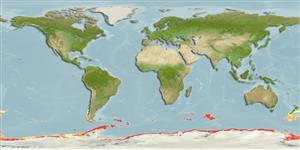Cyclocardia astartoides (Martens, 1878)
| Native range | All suitable habitat | Point map | Year 2050 |

|
| This map was computer-generated and has not yet been reviewed. |
| Cyclocardia astartoides AquaMaps Data sources: GBIF OBIS |
Classification / Names Common names | Synonyms | CoL | ITIS | WoRMS
Bivalvia | Carditida | Carditidae
Environment: milieu / climate zone / depth range / distribution range पारिस्थितिकी
; गहराई सीमा 2 - 3248 m (Ref. 124196). Polar; 49°S - 78°S, 180°W - 180°E
वितरण देश | ऐफ ऐ ओ क्षेत्र | Ecosystems | संयोग | भूमिका
Southern Pacific and the Antarctic.
Length at first maturity / आकार / वज़न / Age
Maturity: Lm ? range ? - ? cm Max length : 3.5 cm SHL पुल्लिंग / अलिंग; (Ref. 798)
Life cycle and mating behavior परिपक्व अवधि | पुनरुत्पत्ति | मछलीऔ का अंडे देना | अंडे | Fecundity | लार्वा
Members of the class Bivalvia are mostly gonochoric, some are protandric hermaphrodites. Life cycle: Embryos develop into free-swimming trocophore larvae, succeeded by the bivalve veliger, resembling a miniature clam.
Main reference
संदर्भ | संयोजक | सहयोगीयो
MarineSpecies.org. 2050. (Ref. 3477)
IUCN Red List Status (Ref. 130435: Version 2024-1)
CITES status (Ref. 108899)
Not Evaluated
CMS (Ref. 116361)
Not Evaluated
Threat to humans
Harmless
Human uses
| FishSource |
साधन
अधिक जानकारी
Trophic Ecology
खाद्य पदार्थ
आहार
आहार खपत
खोराक
परभक्षी
आहार
आहार खपत
खोराक
परभक्षी
Ecology
Population dynamics
Life cycle
Distribution
इंटरनेट स्रोत
BHL | BOLD Systems | CISTI | DiscoverLife | FAO(Publication : search) | Fishipedia | GenBank (genome, nucleotide) | GloBI | Gomexsi | Google Books | Google Scholar | Google | PubMed | Tree of Life | Wikipedia (Go, खोज) | Zoological Record
Estimates based on models
Preferred temperature
(Ref. 115969): -1.8 - 1.9, mean -0.8 (based on 683 cells).



